|
God became man.
The "earthy" reality of the Incarnation is probably one of the main
concepts the focusing on which separates Catholics (and Orthodox) from
most other Christians. Adherents to more Puritanical forms of
Christianity are scandalized by images; seeing a Corpus on a Crucifix
instead of an empty Cross, seeing churches adorned with statues and
other icons, etc. seem so -- "undivine" or "wordly" to these people;
but we Catholics know that Christ, by taking on flesh and becoming man,
redeemed us and gave to us the offer of a dignity which, without Him,
would be impossible. It is to always be remembered that we are not
souls trapped in flesh, but enfleshed souls who are called to use our
bodies and time on earth glorifying Him and, in consequence, becoming
divinized and sharing in His Divine Nature. Our time in this material
world isn't some kind of cruel joke.
All Truth, all Beauty, all Goodness point to Him, amen, and the
beautiful and good things of this world are a shadow of the world to
come. Our statues and other icons help us to see this as they also
inspire us to meditate on the specific divine realities they mean to
convey. When Christ incarnated at the Annunciation and was born of the
Virgin nine months later, He demonstrated one of the first Biblical
Truths: what God made is good, and flesh, while humbling for God to
take on, while weak, and while prone to corruption and sin after the
Fall, is not inherently evil. Christian understanding of the
consequences of this reality is evident from the beginning, as far back
as the Catacombs, and two-dimensional painted icons, statues, and
mosaics have always been used as aids to Christian worship.
Nonetheless, during the 8th c., two great waves of iconoclasm struck
Christianity in the East, the first led by Emperor Leo III who was
influenced by the success of iconoclastic Islam and a revival of the
Monophysite heresy which denied Christ's humanity. Pope Gregory II
denounced Leo and his iconoclastic movement, and the Seventh Ecumenical
Council at Nicaea (A.D. 787) firmly explained the difference between
idolatry and the veneration given to icons. Pope St. Gregory the Great
explained this difference and extolled images' catechetical value in a
letter he wrote to an iconoclast Bishop:
Not without
reason has antiquity allowed the stories of saints to be painted in
holy places. And we indeed entirely praise thee for not allowing them
to be adored, but we blame thee for breaking them. For it is one thing
to adore an image, it is quite another thing to learn from the
appearance of a picture what we must adore. What books are to those who
can read, that is a picture to the ignorant who look at it; in a
picture even the unlearned may see what example they should follow; in
a picture they who know no letters may vet read. Hence, for Barbarians
[those who don't speak Latin] especially a picture takes the place of a
book.
Icon painter,
Leontius the Hierapolian, wrote about the Christian use of images:
I sketch and
paint Christ and the sufferings of Christ in churches, in homes, in public squares and on icons,
on linen cloth, in closets, on clothes, and in every place I paint so
that men may see them plainly, may remember them and not forget them...
And as thou, when thou makest thy reverence to the Book of the Law,
bowest down not to the substance of skins and ink, but to the sayings
of God that are found therein, so I do reverence to the image of
Christ. Not to the substance of wood and paint -- that shall never
happen... But, by doing reverence to an inanimate image of Christ,
through Him I think to embrace Christ Himself and to do Him
reverence... We Christians, by bodily kissing an icon of Christ, or of
an apostle or martyr, are in spirit kissing Christ Himself or His
martyr.
Nonetheless, the
iconoclasts raged on in the East, and Christians there begged the Pope
to intervene, with St. Theodoret writing:
Whatever novelty
is brought into the Church by those who wander from the truth must
certainly be referred to Peter or to his successor... Save us, chief
pastor of the Church under heaven...Arrange that a decision be received
from old Rome as the custom has been handed down from the beginning by
the tradition of our fathers.
Eventually, with
the popular help of Empress Theodora in A.D. 843, the iconoclastic
nonsense was finally squelched, but not until after monasteries were
trashed, icons were smashed, monks were tortured and killed, and relics
and shrines destroyed.
When the same heresy arose in the West during the Protestant
rebellions, the same thing happened: churches and Altars and
altarpieces were destroyed, statues and 2-dimensional icons smashed,
stained glass crushed, chalices and other liturgical
vessels melted down, and monks, nuns,
and priests killed. These things were endured again at the consequent
rise of secularism, especially during the bloody French Revolution,
when a prostitute was "enthroned" at the Altar of Paris's Notre Dame
and renamed the "goddess of Liberty". Nowadays, the
outrages are committed mostly by Muslims and Communists all over the
world; by anti-Christian Jews in Israel; and in isolated but
increasingly common incidents caused by Satanists, rowdy teenagers, and
political activists venting their rage against the Church (there are
also still incidents perpetrated by anti-Catholic Protestants in South
America). In a broader sense, one can see the spirit of iconoclasm in
much of (often publicly-funded) modern "art" with its dung-speckled
Madonnas, Crucifixes submerged in
glasses of urine, etc. (It's fascinating and sad that public money
would never go to fund artistic depictions of Our Lady or the Crucifix
-- unless they were defiled in some way, at which point they become
"art" and matters of "free expression.")
2-D Icons
Though the word
"icon" (also "ikon" or "eikon") refers to religious images of any sort
-- 2-D, 3-D, made of any material, in this section, I will use the word
to refer specifically to two-dimensional representations which have
become highly stylized over time and which one typically associates
with the word "icon." Like all religious images, an icon has as its
purpose acting as a "window to Heaven," a portal through which one sees
greater Truths than can be revealed by word alone.
Christ is the first icon in that He revealed the Father ("He who has
seen Me, has seen the Father," John 14:8-9); we ourselves are creatures
made in the image of God and who are to put on Christ in order to
restore our likeness to Him. We are called to be iconic in that
we are to reveal the Father in our Christian witness, through the grace
of Christ and the Gifts of the Holy Ghost. And, of course, there is the
Holy Shroud which was made without human hands...
While the first Icon Maker is God -- Who begot the Son Who is God and
Who reveals
the Father, Who created us who are called to reveal Him, and Who
miraculously formed the Holy Shroud, St. Luke is said to have made the
first icon made by human hands: an icon called the Hodegetria -- a
prototype of the Eleousa icon (Our Lady of Tenderness) which is an
image of Our Lady holding her Son. Over time, icons came to be painted
according to very definite rules of design and system of symbols (see table below); the arrangement of elements, colors
used, the manner of showing light, etc. are all governed by theological
principles and ecclesiastical custom. Various schools and ages of icon
making arose, each with distinctive styles: the 6th c. Justinian
period; the 10th c. - 12th c. rise of Russian icon writing; and the
"Golden Age of Icons" in the 14th c. Throughout, the representations of
persons were and are meant to capture spiritual realities, not earthly
ones. They are not meant to be realistic portraits of their flesh, but
portraits of their enfleshed spirits, as it were, as seen through the
eyes of faith.
As you can see from where the great schools of icon writing arose,
two-dimensional highly stylized icons are a more important phenomenon
in the East than in the West, where statues, mosaics, illuminated
manuscripts, stained glass, etc., also had their place, and the means
of the veneration of images in the East and West also differ according
to custom:
East:
prostrations (inside of Lent), bows (outside of Lent), kisses to the
feet or hem of the one depicted, incense, processions,
and burning
candles before the image are used to show one's veneration for the
Divine Reality presented by the image
West:
kisses to the feet or hem of the one depicted, touching the image,
burning candles before the image, kneeling, incensing, processions,
adornment with flowers, and crownings (esp. of Marian icons) are more
the form. Prostrations are reserved for the Crucifix. (See more on posture and gesture here.)
Veneration is
also shown to some icons by decorating them with gems and/or a cover
(called an oklad) made of silver, gold or other metal.
Symbology in Icons
| Hands |
hands are often
shown giving a blessing: the last two fingers touching thumb (two
fingers raised) symbolizes the two natures of Christ; ring finger
touching thumb (three fingers raised) symbolizes the Trinity.
Hands are also shown with with the forefinger extended straight; the
middle finger curved slightly; the thumb and the ring finger crossed;
and the little finger curved slightly. This gesture forms the letters
"IC XC" (Greek letters for "Jesus Christ") -- the first finger making
the I, the curved middle finger forming the C, the crossed ring finger
and thumb forming the X, and the pinky finger forming the second C. |
| Eyes |
large to show
faith in God ("the eyes of faith") |
| Ears |
large to show we
must listen to God |
| Position |
usually, divine
and saintly figures face forward; others are in profile |
| Light |
Light source
shown as coming from within the Divine or divinized Person or persons |
| Color |
Gold: Divine
Light, Christ Himself
White: eternal Light, the Father
Green: Holy Spirit, regeneration
Blue: faith, humility
Red: youth, beauty, war, love
Purple: royalty, priesthood
Bright Yellow: Truth
Pale Yellow: pride, betrayal
Brown: death to the world
Black: evil, death |
| Time and Space |
earthly
perspective is lost and icons have a flatness to them that disappears
in Western Art after the painter Giotto discovered the rules of
painting using perspective. Time, too, is distorted to show sequential
events simultaneously. Both of these phenomena lend themselves to
aiding the viewer in realizing that he is not looking at temporal
realities, but spiritual realities |
| Evangelists |
wear tunics,
carry a book |
| Bishops |
wear vestments,
carry a book or scroll |
| Monks |
wear habits,
stand very erect |
Reading Icons
Let's take a
look at the icon of Our Lady of Perpetual Help (also called "Our Mother
of Perpetual Help" and "Virgin of the Passion") to get an idea of
how to read icons. But first, a little history, because the story of
this icon is so interesting.
No one is sure about the origins of the icon, but it came from Crete
and is a "Hodegetria" style icon (see below). A merchant there heard of
many miracles surrounding the icon and, wanting it for himself, stole
it and took it with him in his travels. He ended up in Rome, and on his
deathbed, told a local Roman about how he'd acquired the icon and asked
him to take it to a church where it could be enjoyed by many. The
Roman's wife, though, had other ideas and kept the icon in her bedroom.
Mary appeared to the Roman many times in visions, asking him to take
the icon to a church. When this didn't happen, Mary appeared to the
Roman's six-year old daughter and told her the icon should be taken to
St. Matthew Church. The Roman family obeyed, and there the icon
remained, venerated by many who came to contemplate its message, until
1798 when Napoleon's army invaded Rome and Napoleon (what else?)
ordered the destruction of churches. The icon disappeared.
Around 50 years later, a sacristan in a church in France told an altar
boy that the painting that had hung in their own church for almost a
half-century was very old and used to hang at St. Matthew's church in
Rome. It had been saved from destruction and secretly carried to their
parish church, and he wanted the boy to remember this so someone
would know the story.
More years pass, and the altar boy had become a Redemptorist in Rome.
His Order took over an estate that just happened to include the old St.
Matthew church, and while researching the history of the place, they
learned of the beautiful icon that had disappeared. The former altar
boy remembered what the sacristan had told him and relayed the story to
his Brothers. The Redemptorists appealed to Pope Pius IX, reminding him
that it was Mary's own wish that the icon be hung at St. Matthew's
church. The Pope intervened, restoring the icon to its now rightful
place, and telling the Redemptorists to make Our Mother of Perpetual
Help their mission, spreading knowledge of her and her icon throughout
the world. This they have done.
And now on to the icon itself:
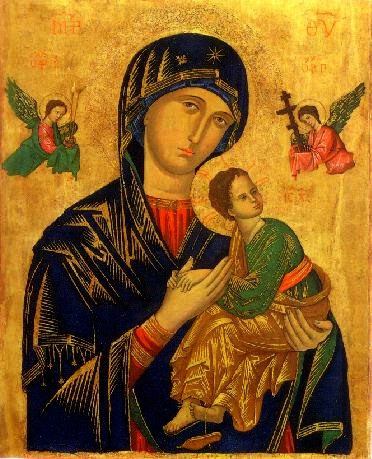
Mary's gaze is aimed directly at you, as though she wants you to meet
her eyes and ponder. The Greek letters above -- MR QU -- tell us that she
is the Mother of God, and, against a background of gold (divine light),
she wears a dark blue robe (faith, humility) with a green lining (Holy
Ghost) and a red tunic (beauty).
Baby Jesus, identified by the letters "IC XC," doesn't look at His
mother or at us in this icon; instead, He is looking away, having seen
something that made Him afraid -- so afraid that He ran to His mother
fast enough that He lost one of His little sandals. What does He see?
His destiny, symbolized by the angels bearing the instruments of His
Passion. The angel to the left, Michael, carries the lance that will
pierce His side, an urn filled with gall, and the reed and sponge which
will carry it to His lips. The angel to the right, Gabriel, bears a
Cross and four nails. His earthly comfort, and ours, is in His mother,
and as He clings to her, she, with her gaze, invites us to do the same.
Icon Styles
Below are
descriptions and pictures of some of the most famous icon types. You
will see the same artistic elements and schemes in icons from different
eras and ritual Churches, in different styles, but with recurring
themes and standardized types.
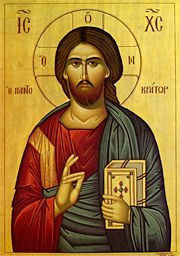 |
Pantocrator
(Ruler of All, Christ the Teacher)
Christ as
Teacher holding a book, two fingers (raised in a blessing) indicating
His two natures
|
 |
Hodegetria
(Grebenskaya, Our Lady of the Way, The Leader, The Guide of the Church)
Mary holding
Christ and pointing toward Him. The prototype is said to have been
written by St. Luke. (The Polish depiction of Our Lady of Czestochowa,
the famous "Black Madonna," is a variation of the Hodegetria style
icon, as are St. Luke's "Salus Populi Romani" icon kept at St. Mary
Major Basilica , the icon of "Our Lady of Perpetual Help," the "Virgin
of the Three Hands," and "Our Lady of Kazan" ("Kazanskaya") (see below
for some of these in more detail))
|
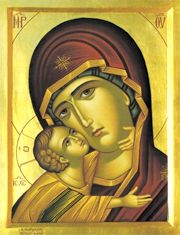 |
Eleousa
(Elouesa, The Tender Mercy, Virgin of Loving Kindness, Tender Touch,
Sweet Kissing)
Mary holds her
Son, Who touches His face to hers and wraps (at least) one arm around
her neck or shoulder (See La Bruna icon below)
|
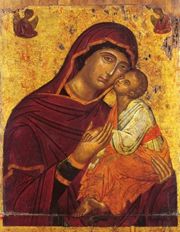 |
Glykophilousa
(Oumilenie, Virgin of Tenderness, Who Embraces Gently)
Like the
Eleousa, but the Theotokos embraces Jesus Who caresses her chin
|
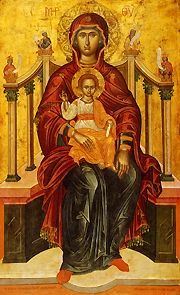 |
Panakranta
(Kyriotissa, Queen of Heaven, She Who Reigns in Majesty)
Mary regally
enthroned with Baby Jesus on her lap
|
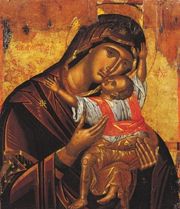 |
Virgin
Kardiotissa
(Close to the Motherly Heart)
Mary holding
Jesus with their faces touching, His arms are flung wide open around
her neck
|
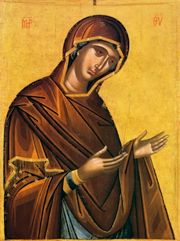 |
Agiosortissa
(Intercessor)
Mary is shown
alone, in profile, facing toward her left (toward Christ), with hands
held out in supplication
|
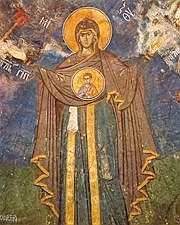 |
Virgin
Orans
(the Orante, the Oranta)
Mary is shown
with arms in orante position. A most popular form of this style is the
"Lady of the Sign" (a.k.a. Virgin of the Incarnation, Platytera, or
Panagia), shown at left, in which Mary is shown with arms in orante
position, with Christ enclosed in a circle in her womb. When Christ is
shown in Mary's womb like that, she is known as the "Mother of God of
the Sign," hearkening back to the words of Isaias 7:14, "Therefore the
Lord himself shall give you a sign. Behold a virgin shall conceive, and
bear a son, and his name shall be called Emmanuel." Such icons are
favorites among those who fight abortion.
|
Particular Icons You Should Know
We've already
seen the icon of Our Lady of Perpetual Help, but there are other
particular icons that you should be familiar with:
Salus Populi
Romani
St. Luke is said to have written the famous "Salus Populi Romani"
("Protector of the Roman People") Hodegetria-style icon, shown at
right, which was brought from the Holy Land to Rome by Helena,
Constantine's mother. It is housed in St. Mary
Major Basilica in Rome, a Basilica which was built in response to a
miracle: in A.D.. 358., Our Lady appeared to Pope Liberius and a couple
and told them to build a church at a place she would mark out with snow
on Esquiline Hill. On an August night, she did just that -- a
church-sized, church-shaped area of snow fell on the hill. The people
staked out the area "Our Lady of the Snows" indicated, the Basilica was
built, and Pope Liberius consecrated it. It has been rebuilt over the
years, lastly by Pope Paul V (1605-1621). The Feast of the dedication
of the (original) Basilica is August 5, and in commemoration of the
miraculous snowfall, white rose petals are sprinkled down from the dome
during the Mass that day.
During St. Gregory the Great's pontificate (A.D. 590-604), in the year
A.D. 597, this icon was carried in procession to Hadrian's tomb during
a time of a great plague. Upon arrival at the destination, a choir of
angels was heard singing:
Regina coeli,
laetare, alleluia;
Quia quem meruisti portare, alleluia;
Resurrexit sicut dixit, alleluia.
(Queen of Heaven, rejoice, alleluia;
For He Whom you did merit to bear, alleluia;
Has risen as He said, alleluia.)
To which St.
Gregory replied:
Ora pro nobis
Deum, alleluia.
(Pray for us to God, alleluia.)
Then St. Michael appeared over
the tomb, with sword drawn -- and put his sword back in its sheath as a
sign of the end of the pestilence. This appearance of the Archangel is
the reason why Hadrian's tomb is now known as Castel Sant'Angelo.
In this icon, Mary, dressed in a red tunic and a dark blue mantle with
gold trim, holds Jesus in her left arm. Jesus gazes as His mother as He
holds a book and raises His hand in blessing. Unlike most Hodegetria
type icons, Mary does not point to Christ.
|
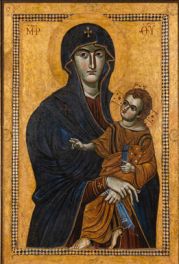 |
|
Our Lady With
Three Hands
Another
Hodegetria-style icon you should be familiar with
is the icon known as "Virgin Tricherousa," or "Our Lady With Three
Hands." St. John Damascene (ca. A.D. 676-754/87, Feast Day 27 March), a
great fighter against the iconoclasts, was accused of being an enemy of
the state in which he lived, and as punishment, the Caliph ordered that
one of his hands be chopped off. Afterwards, St. John took the severed
hand, prayed in front of an icon of Our Lady (one said to have been
written by St. Luke), and then fell asleep, waking to find that his
hand was healed. In honor of that healing, he made a hand of silver and
added it to the icon. The altered icon has been duplicated ever since.
You can see the silver third hand in the lower left of the picture.
This icon is at the Serbian Monastery of Chiliandari, Mt. Athos ("Holy
Mountain"), near Ouranoupolis, Greece (in Orthodox hands).
|
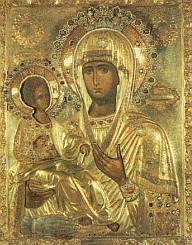 |
|
Our Lady of
Czestochowa
The icon of Our
Lady of Czestochowa -- another icon in the Hodegetria style -- is
another important image, and one with an important and miraculous
History. One of the "Black Madonnas," she can be recognized by her dark
skin tone (partly due to style, partly due to the effects of smoke from
candles), the jeweled clothing, and the slash marks on the cheek (hard
to see in the image at
right, but obvious in person and in good reproductions). This icon is
another said to have been written by St. Luke, and allegedly was
brought from Jerusalem to Constantinople by St. Helena. It ended up in the hands
of the princes of Ruthenia, then was taken to Poland by Prince
Ladislaus, who kept it in the chapel of the Castle of Belz. When the
Saracacens attacked the castle, one of their arrows scarred the throat
of the image. Praying to Our Lady to discover where to place the icon
to keep it protected, Prince Ladislaus had a dream in which he was told
to leave the image on Jasna Gora (Bright Hill) in Czestochowa, where
the icon remains today. He built a monastery and church there and, in
1382, asked Pauline monks to act as guardians of the icon.
In 1430, iconoclast Hussites attacked the monastery and tried to steal
the icon -- but their horses wouldn't budge when they attempted to
carry it away. In a rage, they broke the icon into three pieces and
slashed the cheek of Our Lady's image three times; at the third slash,
the swordsman died! These slash wounds cannot be repaired, though many
had tried over the years.
In 1655, Swedish soldiers, said to have been 12,000 in number, went up
against the monastery but were held off by the 300 religious who had
Our Lady to protect them; in gratitude, King John Casmir declared Mary
Queen of Poland.
In 1920, the Russians gathered in the area to prepare to attack the
Polish people. But the people beseeched Our Lady, and the next day (15
August, the Feast of the Assumption), her image appeared in the skies,
sending the Russians fleeing.
The golden crown that adorns the image today was a gift of St. Pius X
(but Pope Clement XI crowned the image in 1717. Reproductions of the
icon paint in the crown). Many, many miracles are associated with this
icon, and it is quite dear to the Polish people.
|
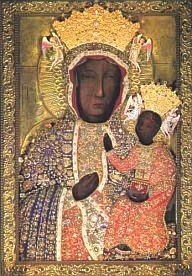 |
Our Lady of
Kazan
The ultimate origin of the 13th c. Our Lady of Kazan icon (known as
Kazanskaya in Russia) is unknown, but it is said to have been found on
8 July 1579 by a ten-year-old girl, Matryona, who had a dream of the
image resting under ashes in the ruins of one of the Kazan houses.
Legend says that this icon helped the Kazan militia liberate Moscow
from the Polish invasion in 1612.
It was kept in Moscow's Kazan cathedral for a time, but was transferred
to St. Petersburg by Peter the Great. It was stolen during the Russian
Revolution and sold abroad along with other church valuables. The Blue
Army (a Roman Catholic group devoted to Mary) bought it around 1970
from an American collector and presented it to Pope John Paul II in
1993. The Pope, in a move very controversial among traditional
Catholics, returned the icon to Russia in 2004.
|
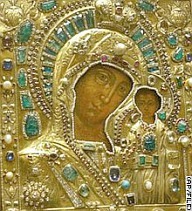 |
La Bruna
I also have to
mention the "La Bruna" ("The Brown One"), an icon that is of the
Eleousa style but shows Mary with a star with one long tail on her
right shoulder reflecting her purity. Again Our Lady is wearing a red
tunic and blue mantle and veil, which Jesus clings to.
Though it
doesn't show up in this reproduction, Jesus and Mary are surrounded by
large halos, hers with 12 rosettes representing the 12 Tribes and 12
Apostles, His with the Cross. This icon is a 12th c. Carmelite icon,
the original of which is in the Basilica of Carmine Maggiore in Naples,
Italy. |
 |
For other important images, some miraculous, see:
 Infant of Prague, Santo Bambino di Ara
Coeli, & Maria Bambina on the "Devotion to the Child Jesus" page Infant of Prague, Santo Bambino di Ara
Coeli, & Maria Bambina on the "Devotion to the Child Jesus" page
 Our Lady of Good Success in Quito
on the Marian Apparitions page Our Lady of Good Success in Quito
on the Marian Apparitions page
 Our Lady of Guadalupe on the Our Lady of
Guadalupe and the Tilma of St. Juan Diego page Our Lady of Guadalupe on the Our Lady of
Guadalupe and the Tilma of St. Juan Diego page
|
|















Infant of Prague, Santo Bambino di Ara Coeli, & Maria Bambina on the "Devotion to the Child Jesus" page
Our Lady of Good Success in Quito on the Marian Apparitions page
Our Lady of Guadalupe on the Our Lady of Guadalupe and the Tilma of St. Juan Diego page